'Zombie deer disease' epidemic spreads in Yellowstone as scientists raise fears it may jump to humans | Wildlife | The Guardian
Category: News & Politics
Via: perrie-halpern • 2 years ago • 13 commentsBy: the Guardian Phoebe Weston and Patrick Greenfield
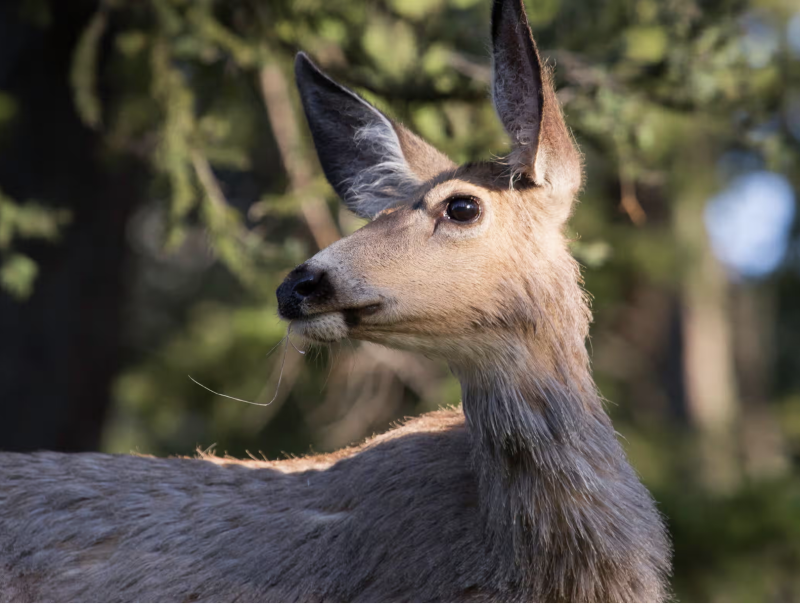


Warnings that 'slow-moving disaster' in North America raises chances of fatal mad cow-type disease jumping species barrier
W hen the mule deer buck died in October, it perished in a place most humans would consider the middle of nowhere, miles from the nearest road. But its last breaths were not taken in an isolated corner of American geography. It succumbed to a long-dreaded disease in the backcountry of Yellowstone national park, north-west Wyoming - the first confirmed case of chronic wasting disease in the country's most famous nature reserve.
For years, chronic wasting disease (CWD), caused by prions - abnormal, transmissible pathogenic agents - has been spreading stealthily across North America, with concerns voiced primarily by hunters after spotting deer behaving strangely.
The prions cause changes in the hosts' brains and nervous systems, leaving animals drooling, lethargic, emaciated, stumbling and with a telltale "blank stare" that led some to call it "zombie deer disease". It spreads through the cervid family: deer, elk, moose, caribou and reindeer. It is fatal, with no known treatments or vaccines.
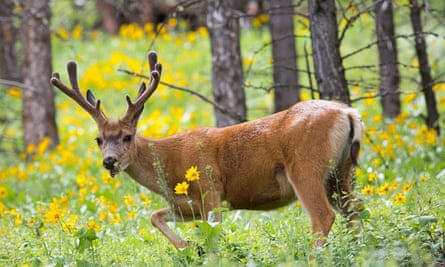 Mule deer ( Odocoileus hemionus ) are common in Wyoming. One estimate in 2017 suggested humans could be eating up to 15,000 CWD-infected animals a year in the US.
Mule deer ( Odocoileus hemionus ) are common in Wyoming. One estimate in 2017 suggested humans could be eating up to 15,000 CWD-infected animals a year in the US.
Its discovery in Yellowstone, whose ecosystem supports the greatest and most diverse array of large wild mammals in the continental US, represents an important public wake-up call, says Dr Thomas Roffe, a vet and former chief of animal health for the Fish & Wildlife Service, a US federal agency.
"This case puts CWD on the radar of widespread attention in ways it wasn't before - and that's, ironically, a good thing," he says. "It's a disease that has huge ecological implications."
Roffe had been predicting CWD would reach Yellowstone for decades, warning that both the federal government and the state of Wyoming needed to take aggressive measures to help slow its spread. Those warnings went largely unheeded, he says, and now the consequences will play out before the millions who visit the park each year.
The area constitutes a vast laboratory for observing what happens when CWD infiltrates an ecosystem with its original full complement of biological diversity. Hundreds of thousands of elk and deer move through Yellowstone, supporting populations of grizzly bears, wolves, cougars, coyotes and other scavengers.
The disease is a "slow-moving disaster", according to Dr Michael Osterholm, an epidemiologist who studied the outbreak of bovine spongiform encephalopathy, or "mad cow disease" - a related prion condition - in the UK, and is director of the Center for Infectious Disease Research and Policy at the University of Minnesota.
Dr Cory Anderson recently earned his doctorate studying with Osterholm, focusing on pathways of CWD transmission. "We're dealing with a disease that is invariably fatal, incurable and highly contagious. Baked into the worry is that we don't have an effective easy way to eradicate it, neither from the animals it infects nor the environment it contaminates."
Once an environment is infected, the pathogen is extremely hard to eradicate. It can persist for years in dirt or on surfaces, and scientists report it is resistant to disinfectants, formaldehyde, radiation and incineration at 600C (1,100F).
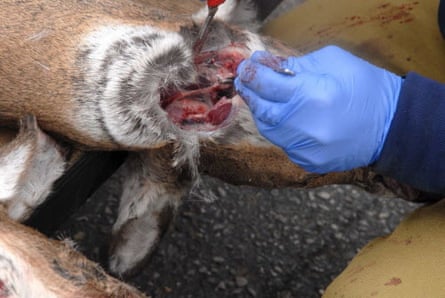 A wildlife expert remove lymph nodes from a deer to check for CWD.
A wildlife expert remove lymph nodes from a deer to check for CWD.
Jumping the species barrier
In the US and Canada, CWD has gained attention not only because it affects big-game animals but also because of the possibility that it could jump the species barrier. Deer, elk and moose could infect livestock, other mammals, birds or even humans. Epidemiologists say the absence of a "spillover" case yet does not mean it will not happen. CWD is one of a cluster of fatal neurological disorders that includes BSE.
"The BSE [mad cow] outbreak in Britain provided an example of how, overnight, things can get crazy when a spillover event happens from, say, livestock to people," Anderson says. "We're talking about the potential of something similar occurring. No one is saying that it's definitely going to happen, but it's important for people to be prepared."
Dr Raina Plowright, a disease ecologist at Cornell University, says CWD should be viewed against a backdrop of dangerous emerging zoonotic pathogens that are moving back and forth across species barriers between humans, livestock and wildlife globally. Outbreaks occur as human settlements and agricultural operations press deeper into environments where contact with disease-carrying animals is increasing.
With the hunting season under way in the US, the US Centers for Disease Control and individual states strongly recommend that harvested game animals be tested for disease, and that meat from cervids that appear ill should not be consumed.
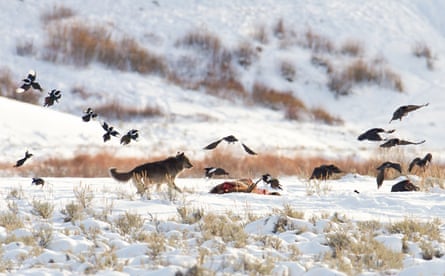 A wolf chases magpies and ravens from an elk carcass in Yellowstone. Predators such as wolves and cougars detect sick animals long before humans do and so far have been immune to CWD.
A wolf chases magpies and ravens from an elk carcass in Yellowstone. Predators such as wolves and cougars detect sick animals long before humans do and so far have been immune to CWD.
The Alliance for Public Wildlife estimated in 2017 that 7,000 to 15,000 CWD-infected animals a year were unwittingly being eaten by humans, and that the number was expected to increase 20% annually. In Wisconsin, where testing of game meat is voluntary, Anderson and Osterholm say many thousands of people have probably eaten meat from infected deer.
skip past newsletter promotion
after newsletter promotion
Wyoming serves as a reference point for other states. Since 1997, there have been 92,000 tissue samples collected and tested there, said Breanna Ball, of the Wyoming Game and Fish Department. Last year, the meat from 6,701 deer, elk and moose was tested. Disease was present in about 800 samples, suggesting infection rates are rising.
According to the US Geological Survey, CWD is now present in 32 states and three Canadian provinces.
Slowing the spread
In the wake of the confirmation of CWD in the park, the Yellowstone authorities are revising their strategy for surveillance and dealing with more sick animals in the future. Roffe says CWD virulence is "density dependent", meaning infection rates are higher where large numbers of animals congregate.
Especially problematic, he notes, is the controversial artificial feeding of wildlife by humans. In Wyoming, the state and federal government operate nearly two dozen "feedgrounds" for elk, where more than 20,000 animals are given alfalfa to help them survive the winter. The practice is condemned by leading wildlife management organisations.
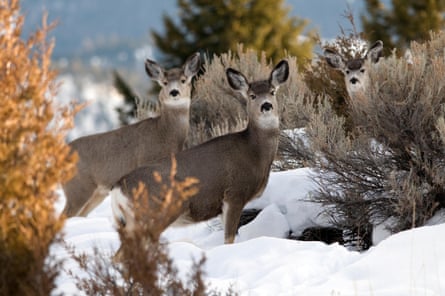 Mule deer in Yellowstone. Conservationists say feeding deer and elk in the winter and killing predators such as wolves is not helping efforts to contain CWD.
Mule deer in Yellowstone. Conservationists say feeding deer and elk in the winter and killing predators such as wolves is not helping efforts to contain CWD.
"The science of what's needed to help slow the spread of CWD is clear, and has been known for a long time," Roffe says. "You don't feed wildlife in the face of a growing disease pandemic."
Studies suggest that animals which some hunters regard as competitors may actually be allies. Wildlife predators such as wolves, cougars and bears are able to detect sick animals long before humans do, and they will prey on them, removing them from the landscape. So far, they have maintained immunity from disease.
A major policy contradiction, wildlife conservationists say, is that Wyoming, Montana and Idaho, the three states that make up the Greater Yellowstone Ecosystem, which some estimate to stretch for 90,000 sq km (35,000 sq miles), encourage the liberal killing of wolves and cougars for sport and livestock protection, even when doing so is unnecessary and may be counterproductive to controlling CWD.
Mass deaths of elephant seals recorded as bird flu sweeps across the AntarcticRead more
"We're still at the front end of a scary disease event, and we don't know where it's headed," Roffe said. "There's a lot at stake for the Yellowstone ecosystem, and a lot at stake for all Americans who enjoy having healthy wildlife on the landscape."
Find more age of extinction coverage here, and follow biodiversity reporters Phoebe Weston and Patrick Greenfield on X for all the latest news and features





CWD is a huge problem here in the deer population and even with the moose on Isle Royal MI State Park.
Even though no human case of Mad Cow has been shown in humans I'm barred from giving blood because I could have eaten tainted British beef while I was stationed in Germany in the mid-80's.
Wow...that was over 30 years ago! I think if you haven't exhibited symptoms by now I think you're gonna live.
Arkansas has a problem with CWD. We have large white tail deer and elk populations. Game and Fish is trying to keep the disease isolated in the counties it's showed up in
I'm a little salty about not being patient zero for the zombie apocalypse.
I just looked it up online and I probably can donate blood now though. I just haven't been to a blood drive since the kept turning me away in the 90's.
[removed]
what the hell did you say this time?
based upon the disease symptoms, I implied that it had already jumped to humans of a specific demographic.
oh
meh, I thought it was funny, but I guess my fan club disagreed...
Seems to me mad cow disease made its appearance before wasting disease was seen in deer etc. . As a former born and raised Mont. resident, my father and I often speculated that the disease was spread to wildlife thru the BLM policy of leasing government controlled range and forrest land to ranchers for grazing in spring thru fall. That policy certainly led to greatly diminished forage for wildlife during winter, causing them to invade ranchers haystacks, causing over hunting game animals thru extended seasons, causing over zealous hunters to trespass and harm ranchers land and livestock. Overgrazing of public lands for profit led to the current maze of hunting regulations and the burgeoning business of guide services. Its turned what used to be a sport into another money making scheme for the state of Mont. and caused big money individuals to purchase large parcels of land and restrict access to all forms of outdoor recreation.
I remember hearing about mad cow disease in the late 80's early 90's
I remember getting into trouble making some inappropriate references and jokes about it.
Been awhile ago, but seems Mont. believed it spread to the high-line states from Canada. Imported from Great Britain. Stopped importation of breeding stock .
I never heard that but it makes sense. Maybe deer should have passports